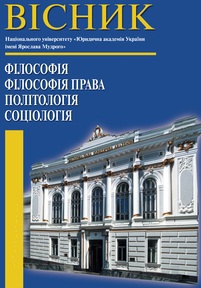МЕЖІ МОЖЛИВОГО І ДОПУСТИМОГО В ТЕХНОЛОГІЧНОМУ ПІДХОДІ ДО ПРАВОВОГО ЗНАННЯ
THE LIMITS OF THE POSSIBLE AND PERMISSIBLE IN THE TECHNOLOGICAL APPROACH TO LEGAL KNOWLEDGE
Author(s): Zhanna PavlenkoSubject(s): Law, Constitution, Jurisprudence, ICT Information and Communications Technologies, Philosophy of Law
Published by: Національний юридичний університет імені Ярослава Мудрого
Keywords: innovations in law; digitization of law; intellectual legal systems; technologies of artificial intelligence in law; digital reality;
Summary/Abstract: Problem setting. New complex challenges of the present, including transformation and complication of heterogeneity and entropy of the Internet space, intensive development of robotics, technologies of artificial intelligence, can not but affect the state and development of the entire legal system of the state and legislation in various spheres of public relations. It is necessary to formulate criteria for a typology of legal problems that can be solved by digital formalization, and which require the use of the potential of "personal knowledge" to which intuition and practical experience are involved, etc.Recent research and publications analysis. The results of studies of these problems make it possible to point out that, as a whole, a systematic scientific understanding of the complex, voluminous and multidimensional problem of clarifying the perspectives and limits of the technological approach in professional legal practice, legal expert activity, influence on the transformation of legal norms, jurisprudence and legal education and the like need further careful study. The rapid development of new technologies, in particular artificial intelligence technologies, the Internet of Things, cloud technologies, etc., is contributing to changes in current legislation. Today, advanced economies are already pondering the question of regulating the status and use of AI technologies. While these are only the first bold steps, in the future, all of these can affect global changes in the legal system - perhaps full-fledged comprehensive institutions of law and institutions of law, even the branches and branches of law.Paper objectiv. The purpose of this article is to consideration of certain aspects of digitization of law and the limits of possible and admissible in the technological approach to legal knowledge on the basis of the results of understanding of this problem by different representatives of the humanities and interdisciplinary researchers.Paper main body. The article substantiates the importance and methodology of the technological approach in law, the limits of the use of this approach. It is shown that since the intensive development of innovative technologies, their widespread adoption in various spheres of public life is a significant factor in the development of modern society, this gradually leads to the formation of a new "digital" reality. It is disclosed that innovative technologies are not only potentially applicable, but have long been effectively used in the legal sphere, due to which, in particular, the correct and quick solution of various tasks is ensured, which contributes to more efficient provision of legal services, ensuring professional legal practice, etc. It is revealed that in the new reality, law becomes not only a means, a tool that provides digitalization of the economy, management and other segments of society, but also the object of digitalization, as a result of which it experiences changes in its form, content, system, structure, mechanism of action and demonstrates tendencies to strengthen these transformations.Conclusions of the research. In the face of new reality, law becomes not only a means, a tool that ensures the digitization of the economy, governance and other segments of social life, but also the object of digitalization, in which it changes its form, content, system, structure, mechanism of action and demonstrates a tendency to enhance these transformations. The following are legally and in fact possible and relevant directions and forms of the use of artificial intelligence technologies in legal practice, in particular in the judiciary: information and documentary support of legal practice, which includes automated intellectual classification of legal documents, formation and documentation of cases, elaboration through the use of artificial intelligence technologies of projects of solutions to various legal problems by means of using and analyzing databases; intellectual expert-analytical support of legal practice by comparison of technologies of artificial intelligence of norms of law, comparison of normative legal acts in order to determine their hierarchy, establishment of norms and acts of higher legal force from among those that are compared; generating and issuing expert assessments within the framework of forensic expertise or specialist opinion (use of knowledge bases (expert systems), automated systems for supporting legal decisions based on artificial intelligence); facilitating decision-making on large volumes of heterogeneous tasks in difficult uncertainty conditions, based on inaccurate, insufficient or poorly structured information.
Journal: Вісник НЮУ імені Ярослава Мудрого. Серія: Філософія, філософія права, політологія, соціологія
- Issue Year: 44/2020
- Issue No: 1
- Page Range: 132-146
- Page Count: 15
- Language: Ukrainian

